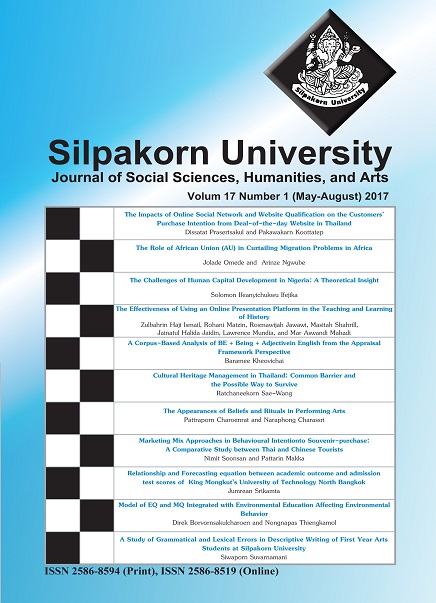The Appearances of Beliefs and Rituals in Performing Arts
Main Article Content
Abstract
The objectives of this paper are to study the strategy and the creativity of performing arts related to rituals and beliefs whose contents have reflected the social, environmental and political situations at that time. This paper has applied the communication approach of “Roman Jacobson’s Communication Model”, Semiology Model and Fine Arts Creativity Model.
After studying, it is found that the most important elements to express the ritual and belief through performing arts are body movements, music, playwright, costumes and setting. The second important elements are space occupying, actor casting, and stage lighting. However, the performing arts, related to rituals all over the world, have been originated from local belief which has been repeatedly practiced for ages. Consequently, the people believed its sacredness and they had been obliged to hold the holy ritual regularly in the belief that there would be good fortunes fall upon them and their society in return.
Downloads
Article Details
All rights reserved. Apart from citations for the purposes of research, private study, or criticism and review,no part of this publication may be reproduced, stored or transmitted in any other form without prior written permission by the publisher.
References
Charassri, N. (2016) Lecturer at Dance Department, Faculty of Fine and Applied Arts, Chulalongkorn University, Bangkok, Thailand. Interview. April 11, 2016.
Hamza, H. Z. (2015) The Relationship between Ritual of Eagle Dance by Bajau Laut, the indigenous in Malaysia. Paper Presented at the SAC International Conference, Bangkok, Thailand. September 4-6, 2015. Retrieved on July 26, 2016, from www.sac.or.th/interconference/2015/?p=604
Hewett, I. (2013) Did The Rite of Spring really spark a riot?. BBC NEWS MAGAZINE. Retrieved on April 28, 2016, from https://www.bbc.com/news/magazine-22691267
Karom, C. (2016) Lecturer at Department of Contemporary Performing Arts Communication, Faculty of Communication Arts, Kasem Bundit University, Bangkok, Thailand. Interview. July 13, 2016.
Kosonhemmanee, C. (2013) The Forms and Concept in Creating Thai Contemporary Dance of Narapong Charassri. Institute of Culture and Arts Journal 15(1(29)). Retrieved on July 10, 2016, from https://ejournals.swu.ac.th/index.php/jica/article/view/ 3436.
Levison, D. & Ember, M. (1966) Encyclopedia of Cultural Anthropology. New York: Henry Holt and Company.
Manasam, M. (2011) Textile, Costume, Dance. Chiang Mai: Silkworm.
Panomrak, J. (2016) Lecturer at Dance Education Department, Faculty ofEducation, Bansomdejchaopraya Rajabhat University, Bangkok, Thailand. Interview. January 29, 2016
Ponghirun, S. (2016) Lecturer at Performing Arts Department, Faculty of Fine Arts, Srinakharinwirot University, Bangkok, Thailand. Interview. June 2, 2016.
Satpretpry, P. (2016) Lecturer at Department of Contemporary Performing Arts Communication, Faculty of Communication Arts, Kasem Bundit University, Bangkok, Thailand. Interview. August 2, 2016.
Solomon, D., Fan, R. & Ping-cheung, L. (2012) Ritual and The Moral Life. Dordrecht: Springer Netherlands.
Solomon, D., Fan, R. & Ping-cheung, L. (2012) Ritual and The Moral Life. Dordrecht: Springer Netherlands.
Tovititwong, S. (2010) To study the concept, the female dance movement creation and the role of Montho in the contemporary Thai dance “Narai Avatara”. Bangkok: Chulalongkorn University.
The Royal Institute. (1999) Royal Institute Dictionary. Bangkok: Nanmeebooks.
The Thailand Research Fund. (2003) Akha Ritual Belief Truth and aesthetic. Strategy of living of the tribes. Chiang Mai: Wanida Press.
Veraphol et al. (2016) Pee Fah Dance. Intangible Cultural Heritage. Retrieved on April 15, 2016, from https://ich.culture.go.th/index.php/ th/ich/239-rituals/288-----m-s.
Weerakul, S. (2014) Types of Western Performing Arts. Retrieved on July 30, 2016, from https://drama-study.blogspot.com/2014/09/blog-post_26.html


